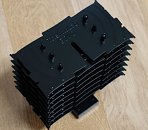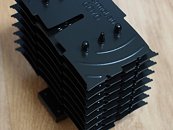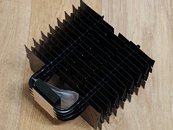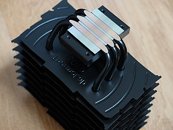- Joined
- Oct 9, 2007
- Messages
- 47,680 (7.43/day)
- Location
- Dublin, Ireland
| System Name | RBMK-1000 |
|---|---|
| Processor | AMD Ryzen 7 5700G |
| Motherboard | Gigabyte B550 AORUS Elite V2 |
| Cooling | DeepCool Gammax L240 V2 |
| Memory | 2x 16GB DDR4-3200 |
| Video Card(s) | Galax RTX 4070 Ti EX |
| Storage | Samsung 990 1TB |
| Display(s) | BenQ 1440p 60 Hz 27-inch |
| Case | Corsair Carbide 100R |
| Audio Device(s) | ASUS SupremeFX S1220A |
| Power Supply | Cooler Master MWE Gold 650W |
| Mouse | ASUS ROG Strix Impact |
| Keyboard | Gamdias Hermes E2 |
| Software | Windows 11 Pro |
ThermoLab, of the BARAM and BADA fame, posted pictures of its next CPU heatsink, named GOYO. This tower-type heatsink may look big in the pictures, but measures just 125 mm x 70 mm x 135 mm, weighing in at just 290 g. It features just 15 asymmetrically shaped aluminium fins, arranged along three 6 mm-thick copper heat pipes that make direct contact with the CPU at the base. Thermolab claims that the GOYO should be able to handle thermal loads of up to 60W fan-less. It can hold on to a pair of 120 mm fans. With its fans installed, the heatsink can handle chips with TDP of up to 95W. The cooler can handle most modern CPU socket types, including LGA1150/LGA1155, AM3+ and FM2+. Thermolab didn't finalize pricing or availability of the GOYO. Find a quick cooling performance preview at the source.




View at TechPowerUp Main Site




View at TechPowerUp Main Site








